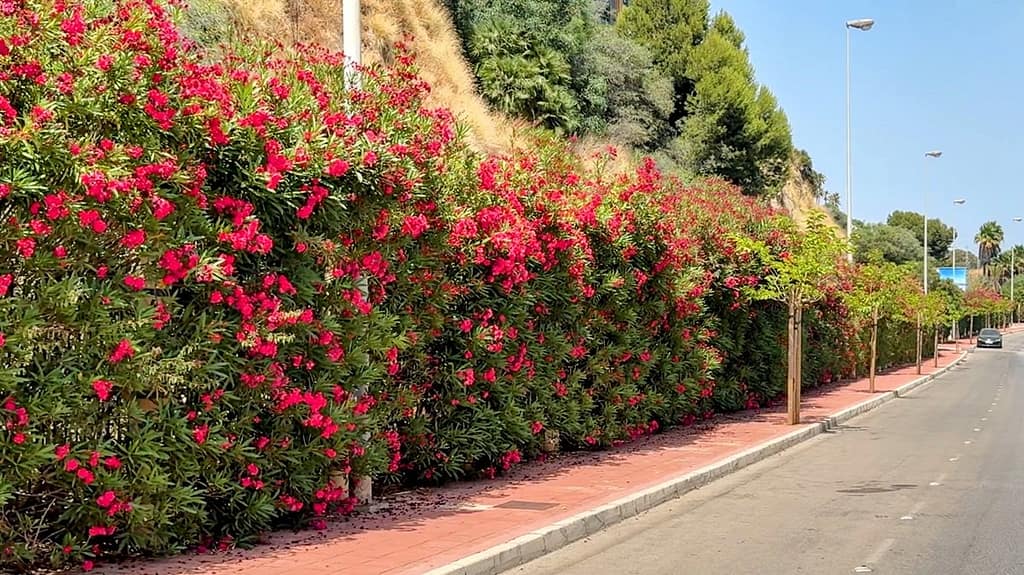4 reasons Oleander plants thrive on Spain’s Costa de Sol

These colorful hedges of Nerium oleander are very popular on the streets and highways on Spain’s southern coast.
Oleander plants are a common sight across southern Spain, especially on the Costa del Sol, where you can see them lining highways and streets, and adorning public spaces and private houses.
So, what is it that makes them so popular in this part of the world? Well, it’s a mix of practical, aesthetic, and environmental reasons, so let’s take a closer look at some of the main ones.
Beauty matters
First things first. Stunningly beautiful oleander plants never fail to draw oohs and aahs from visitors and are treasured by the locals for their ornamental qualities.
They produce showy, fragrant flowers in white, pink, red, and even purple or orange. Adding to their aesthetic appeal, oleander trees have a long blooming season, which contributes to an already colorful palette of Costa del Sol’s picturesque seaside towns.
What’s more, since these tall shrubs are evergreen, their lush green foliage provides year-round greenery, further enhancing the visual charm of what is known as the Sunshine Coast.
For some insights into why this plant often draws oohs and aahs from visitors, watch this short video from the streets of Benalmadena, a coastal jewel next to Malaga, the capital of the Costa del Sol. The abundance and variety of colorful plants in Benalmádena is one of the reasons it’s considered to be one of the most scenic towns in the area.
Oleander plants: hardy fellows, low maintenance

Oleander plants are tough customers, particularly suitable for climate conditions of southern Spain. True to its name, the Costa del Sol, famously, boasts an average of over 320 sunny days a year, and not much rain.
That’s not a problem for oleanders: they are highly drought-resistant and actually flourish in hot, sunny conditions. No less important, they can tolerate the tough soils that are typical in the region. Due to their robust root systems, oleanders also play a role in helping to prevent soil erosion and to stabilize slopes and road embankments.
There is also research that flags the capacity of Nerium oleander to absorb CO2 emissions. That, in part, is the conclusion made by Enrique Figueroa Clemente, a professor at the University of Seville and expert in Ecology, Cytogenetics, and Natural Resources, in his research paper on “Evaluation of the CO2 sink capacity of tree and shrub vegetation suitable for use in the Andalusian road network.”
What’s more, once established, oleanders require minimal watering and care, which is ideal for public landscaping. Oleander trees do require some pruning, since they can grow up to three meters tall.
Road Safety Benefits

If you had a chance to drive along highways in southern Spain, there is a good chance you noticed vibrantly multicolored barriers along median strips or lining the roadsides.
In a publication on road safety, the Spanish Mapfre Foundation highlights some of the traffic benefits of planting oleanders:
“Specifically, separating the directions of travel helps to improve traffic flow and eliminate head-on collisions. Furthermore, they visually separate traffic flows in both directions and at nighttime prevent glare caused by the headlights of oncoming vehicles. Another benefit of the use of oleanders is the impact-absorbing effect of any vehicle leaving the road onto the central median.”
To a degree, they also help muffle traffic noise, creating a quieter and more pleasant driving environment.
The downside of oleanders’ robust growth is that, if left unchecked, it could result in what DGT, Spain’s national government agency responsible for road safety and related matters, describes as a “tunnel effect” that may interfere with drivers’ sightlines.
Regular trimming, however, helps to alleviate the problem and highway authorities in southern Spain continue to use oleander shrubs for their protective benefits. Every year, oleanders and other plants get pruned along thousands of kilometers of highways in Andalusia.
Overall, the stunning beauty and practical benefits of oleander plants make them popular choices in many parts of the world.
In the United States, for instance, International Oleander Society, a non-profit horticultural organization based in Galveston, Texas, writes that “one would have to visit this city of floral beauty to understand why oleanders and Galveston are synonymous.” It adds that the city of Galveston “contains the most extensive collections of ‘Nerium oleander’ to be found anywhere in the world.”
CAUTION: A FEAST FOR THE EYES, NOT THE MOUTH!
While enjoying wide popularity thanks to a mix of practical, aesthetic, and environmental reasons, oleander plants do have a notable drawback: Oleander is a toxic plant; all parts of it are poisonous if ingested by humans or animals.
In some cultures, oleander is utilized for its perceived medicinal benefits, leading to intentional ingestion and subsequent poisoning incidents. In India, for instance, oleander is commonly used in traditional medicine, leading to numerous cases of accidental poisoning. Due to misidentification or incorrect dosage.
Despite the risks, studies have shown that the human mortality associated with oleander ingestion is generally very low, even in cases of intentional consumption (suicide attempts).